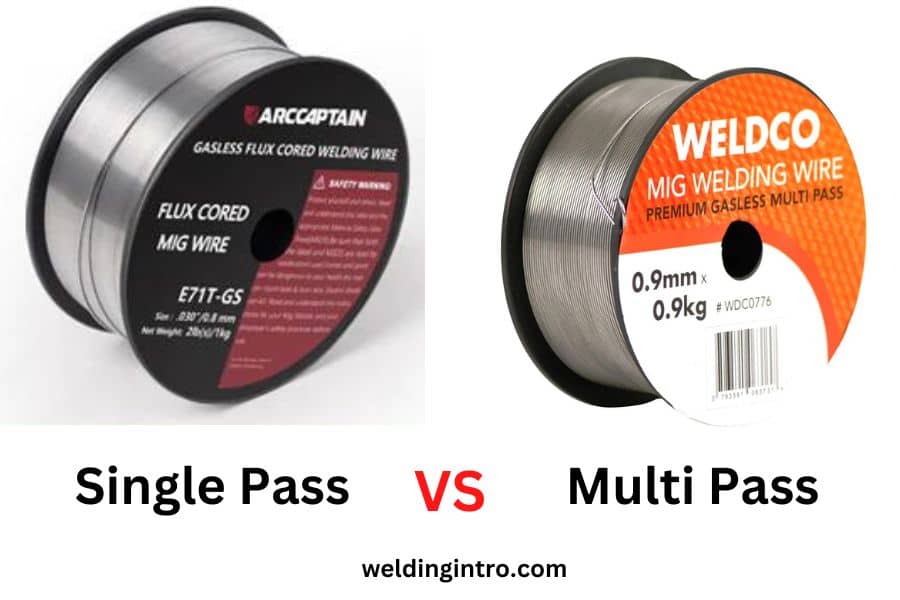When flux core or mig welding you can use either Single pass or multi pass application. But what are they and what are the differences between them?
Let’s describe in brief-
Basic difference: Single-pass welding wire is ideal for thinner materials with a thickness of ¼-inch or less. In contrast, the multi-pass welding wire is perfect for thicker metals that are more than ¼-inch thick.
Single-pass welding wire can’t be used in horizontal or overhead positions. But multi-pass welding wire can be used in any position.

What Is Single Pass Welding Wire?
A single-pass welding wire is a particular type of cable used mainly for thin materials. It is ideally used for a single weld bead pass or application across a crack or joint.
This kind of cable ensures massive stress in the single, complete penetration weld when you let it cool down. Pulling off this type of weld in a horizontal or overhead position is not simple. After all, single-pass welding wire inputs higher heat.
Functions of Single Pass Wire in Flux Core Welding
More than 50% of flux core welding wire is known as single-pass welding wire. The main job of a single-based pass wire in flux core welding is to help the welder weld without using any gas.
Single pass wire generates increased heat at a time to provide slightly more welding power to complete the welding with better penetration.
Advantages of Single Pass Welding Wire
- This type of wire is perfect for a thin section of metals.
- It takes a short time to complete the welding session.
- The welding cable can take load a sufficient amount of heat with a single-based pass.
- Pro welders are benefitted from this single-pass welding wire.
- It ensures a moderate-strength weld due to the limited heat-affected zone.
- The thick bead will have higher residual stresses and a decent appearance.
Where To Use Single Pass Welding Wire?
Single-pass welding wires are perfect for thinners metals. If the thickness of the steel is equal to or less than ¼-inch, you can use single-pass welding wire.
Many sheet metals are compatible to use single-pass welding wire. But considering the capability of the filler metal is crucial too. Make sure to use a 5 mm electrode.
What Is Multi-pass Welding Wire?
A multi-pass welding wire is a wire ideal for thicker metals where you use a special weld to add several layers of the weld. This particular wire can take heavy loads for critical welds.
You can use this welding cable to produce multipass welds for discrete or continuous passes. The multipass welding wire is a must if the steel material is too thick.
Functions of Multi pass Wire in Flux Core Welding
Multipass wires in flux core welding are pretty versatile. You can use them to weld in various positions. But this cable works best for low-alloy formulations and mild steel.
This type of wire allows the welder to add anti-wear coatings to minimize impact and abrasion. Multipass wires in flux core welding have a hollow tube that uses metal powder and flux.
Advantages of Multipass Welding Wire
- Multipass welding wire is ideal for welding thicker sections of metals
- The welding cable is highly compatible with aluminum base and stainless steel materials.
- It can fulfill the requirement of base metal microstructure through welding.
- This type of welding wire offers increased strength of the joint.
- You can achieve a balanced bead appearance.
- It offers precise welding results separately for primary and secondary heat affected zone.
Where To Use Multipass Welding Wire?
Multipass welding wire fits best for steels that have more than ¼-inch thickness. It allows welders to add several layers of welds on the thicker metals.
People usually use multi-pass welding wire for shipbuilding and dense/serious construction, pressure containers, gas and oil middle of a stream pipe.
Difference between Single-Pass and Multi-pass Welding Wire
1.Thinner vs. Thicker Metals
Single-pass welding wire is perfect for thinner metals, which have up to ¼-inch thickness. On the contrary, the multi-pass welding wire is ideal for thinner steel that has more than ¼-inch thickness.
2. Small vs. Larger Heat-Affected Zone
With single-pass welding wire, the heat will be affected in small areas. After all, you continue welding for a short period. But multi-pass welding wire affects a larger welding zone.
3. Slight vs. Considerable modifications
Slight form, shape, or structure modifications occur when you use single-pass welding. But a significant change occurs for multi-pass welding wire due to continuous heating and welding.
4. Medium vs. Superior Weld Quality
Due to the one-time welding approach, single-pass welding wire allows you to achieve a medium-quality weld. The original physical properties will be heavily impacted if you go for several passes.
On the contrary, the multi-pass welding wire is the best choice for achieving superior-quality welding. Welders usually run one after another pass to make the final welding super strong.
5. Beginner Vs. Pro-Friendly
You will need decent welding skills to use single-pass welding wire. Making mistakes will affect the overall result, as you can’t go for several passes. But multipass welding is perfect for beginners. Even if you make any mistakes initially, you can fix the issues later.
How Many Weld Passes On A Multi-Pass Weld Joint?
The numbers of times you need to use multi-pass welding approach solely rely on various factors, such as stringer or weave bead, kind of groove, how fast the weld travel, and electrode diameter.
If you use a higher weld travel speed, several weld pass welding approach is required. Likewise, V-groove will need less number of passes compared to U-groove.
Wrapping Up
Your welding quality often depends on the equipment you use beyond your welding skills. Knowing their ideal usage is crucial when it comes to single-pass vs. multi-pass welding wire. This will help you to get the best result depending on the metal thickness and other factors.
Related Article
Source